**Beyond Control**
*Game Design Document*
Morgan McGuire
[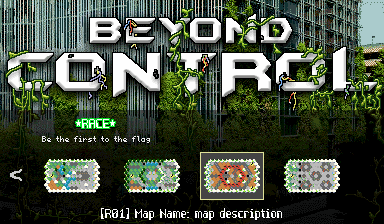 ]("https://github.com/morgan3d/quadplay/blob/master/sprites/blasphemer-tiles-64x64.png?raw=true")
_This is the design document for a game jam Shmuel and I wrote in [quadplay✜](https://github.com/morgan3d/quadplay) with one of my children
over two months. I share my design docs and change logs to help demonstrate process for folks learning
game and software development.
[**Play the final version online**](https://morgan3d.github.io/quadplay/console/quadplay.html?game=quad://games/beyond_control/).
It is best with multiple players and controllers._
**Setting**: Broken-down mechs in a world reclaimed by nature
**Pitch**: RoboRally meets Dominion
**Goal**: Race and battle
**Mechanics**: Real-time, turn-based programming: moving is a puzzle and every second is a potential turn
**Influences**:
- "Out of Control" GMTK2020 jam prompt
- _RoboRally_ movement and broken registers
- _Dominion_/_Magic_ tactical choices
- _Into the Breach_ / _Crysis_ / _The Last of Us_ aesthetics
Reward Cycles
==================================================================
From smallest to largest:
1. Solve the puzzle of combining six operations to move the robot a small distance (~30 sec cycle)
2. Strategically traverse the map, using features to accelerate and shield the robot (~1 min)
3. Complete quest objectives or race and battle challenges per map (~3 min)
4. High score streaks and quest progress, raising difficulty to access more complex instructions (~15 min)
Mechanics
==================================================================
Each player has an `instruction_queue` of instructions to execute.
All instructions take "1 turn" = `INSTRUCTION_FRAMES`. The player
also tracks the `future_hex_angle` that it will be at after the
queue has completed. This is used to compile absolute ACTIONs into
relative rotation INSTRUCTIONs, where the ACTIONs can be compiled at
any point.
All UI only ever requires horizontal input and a single button, including
menus.
Turn Based
------------------------------------------------------------------
Although it feels slow real-time, the game is entirely turn based.
This keeps the mechanics simple and makes it fair.
The real-time feel comes from several key design decisions:
1. Players can put more instructions into their queue at any time
2. Entities that can't interfere with each other can take turns
simultaneously,
3. Rotation instructions are the most common and are uninterruptible
4. Thinking about a move and using the UI take about the amount of
time between turns.
The hex-based movement and "real-time" turn-based gameplay are elements
that I definitely want to re-use in future games. They're a great
way to bring board game ideas into an arcade video game.
Target duration is 10s-1min from launch to actual gameplay, 4 minutes
of play for a race game, and 6 minutes of play for a battle game.
Actions
------------------------------------------------------------------
Action | Compiles To
------------|--------------------
Movement | `ROT` and `MOV`
0x, -1x, 2x | Changes the number of `MOV` instructions
Spin arrow | Changes the number of `ROT` instructions
Forward arrow | `MOV` in the current direction
Burn | `SPRAY`
Freeze | `SPRAY`
Instructions
------------------------------------------------------------------
Instruction | `op` | Parameters | Notes
---------------|---------|-----------------|---------------------------------------------
Rotate | `ROT` | `sign : +/- 1` |
Translate | `MOV` | `sign : +/- 1` | Assumes current direction, plays motor sound. Blockable
Conveyor | `CON` | _none_ | No motor sound. Blockable
Spray | `SPRAY` | `type`: `action_sprite.burn` or `freeze` |
Difficulty Levels
------------------------------------------------------------------
Level| First turn | Reduced duplicates? | Modifiers | Instructions | Evt. Penalty | Evt. Recovery | Score Handicap
-----|-----------------|---------------------|--------------|------------------------------------------------|--------------|---------------|---------
0 | Away from spawn | Yes | 2 (0x & -1x) | Cardinals, 0x, -1x, 2x | 1 reg | 10% | +200%
1 | *Cardinals* | Yes | *2 random* | Cardinals, 0x, -1x, 2x | *2 reg* | 10% | +150%
2 | Cardinals | Yes | *1-3 random* | Cardinals, 0x, -1x, 2x | 2 reg | 10% | +100%
3 | Cardinals | *No* | *0-3* random | Cardinals, 0x, -1x, 2x, *forward* | 2 reg | *5%* | +50%
4 | Cardinals | No | 0-3 random | Cardinals, 0x, -1x, 2x, forward, *rotate mods* | 2 reg | 5% | +0%
The specific registers affected by environmental damage are
predictable so that players can plan around them. Water damages
the two (or 1 for level 0) central registers. Fire damages the
leftmost two (or 1 for level 0) registers.
Coordinate System
==================================================================
"Pointy-up" hexes with directions northeast, east, southeast, southwest,
west, and northwest. 32x32 tiles, where due to shifting each offset row
is 24 pixels above its predecessor. Cheat the perspective to use 2:1 slopes
on the diagonals of the hex. Borders abut unstead of overlapping. Allows
exactly fitting the 384x224 screen and easy coordinate transformations, compatible
with Tiled TMX maps as well.
Most of the game runs in hex coordinates using the axial method and
`xy()` representation.
The world-space pixel `(0, 0)` is at the lower-left of the screen,
which corresponds to the center of a hex in the last row of the map.
The coordinate system math and hex map rendering is in
[`hex_grid.pyxl`](https://github.com/morgan3d/quadplay/blob/master/games/beyond_control/hex_grid.pyxl).
Post Analysis
==================================================================
Reflecting on the game at this point: _Beyond Control_ is now feature complete and
"done" from a game jam perspective. I cut the Quest game type for now. Battle and
Race are fully implemented and have been playtested a bit.
It needs a ton of polish on art, sound effects, and especially UI animations. I came
in around the time limit that I was looking for of "three day jam", but it was spread
over three-plus weeks because of extenuating circumstances and schedules that prevented
me from actually coding very long on any given day.
The scope is kind of aggressive for a jam game at my desired level of completion, but it
worked. I'm very happy that I succeeded in my primary goal, which was making _RoboRally_
more fun and intuitive for players like me who can't deal with either its pacing or the
rotation confusion.
The secondary goals of making a video game that works like a real-time boardgame
mechanically and that uses hex grids were also achieved. The in-game atmosphere in sound
and visuals don't live up to my goals of "city ruins uplifitingly reclaimed by nature", although
the title screen does deliver that acceptably. It satisfies the "out of control" GMTK'20
prompt fully and more-or-less makes that partial loss of control an interesting puzzle instead
of a frustration.
I rate this game a solid B for an experienced developer's jam game, where I think our
previous Ludum Dare _Across the Lake_ was an A.
Quadplay made this game possible. I don't think I could have achieved it within the time
constraints using any other engine right now. The transition to hex coordinates worked
extremely well because the quadplay resolution and math libraries anticipated alternative
schemes. Having Tiled as a map editor made it easy to create lots of maps.
Built-in sprite rotation and scaling were great, and there was plenty of performance for me to just
brute force the graphics and computation. I never optimized anything except the core hex
routines. That wasn't even necessary; it was anticipating future reuse. The map preview rendering is all handled with the camera feature and greatly simplified
the minimap "icons". I thought I was going to have to offline generate the minimap images
by hand, and instead I just brute force rendered multiple maps with extreme zoom at runtime
and it worked.
I used quadplay's `delay()`, `sequence()`, and mode features heavily for animation and UI.
They made it really simple to do things that could have required lots of ugly, buggy code.
This was a big deal and enabled me for the first time to do a lot of UI and UI animation
for a jam game.
I was bitten by checking in the `DEBUG` flag and other debugging options a few times. That
happens on every jam. The upcoming debug constant layer for quadplay will address this
and I can't wait to have that. I used the new CSV file import and in-IDE sprite JSON editing.
The CSV import was convienient, although I could have used JSON or a code generator if
needed. The sprite JSON editing is still not fully supported in quadplay's IDE. It was
just good enough to use, but the 1.0 version will be very welcome. IDE search-and-replace in
files will be handy. I fell back to using `grep` and emacs during some refactoring at the end.
So, no new engine or IDE feature requests from this game, for the first time...just eager
anticipation of the 1.0 features already on the quadplay roadmap.
In terms of workflow, even with diminished resources my standard practice of journaling and
maintaining a bare-bones game design doc worked well. Actually, it helped a lot with
diminished resources because I was able to do most of the design work "offline" and didn't
have to spend much cognition remembering or planning while programming. I put a lot more
into the quadplay `todo()` system than the design doc for actual TODO lists and that was
both effective and motivating.
Photoshop + Audacity + ImageOptim + Tiled were fine tools as always and interacted well
with the IDE. git was adequate in this case and I never got bitten by anything with it,
probably because there were only two of us.
I should have chosen a single area of focus instead of two. I had an aggressive
gameplay/mechanic idea _and_ a strong thematic vision. Because I ultimately had to
choose between them, I executed on the
gameplay but did not succeed with the theme. It would have been better to adopt existing
assets almost entirely (although good hex assets are tough to find) or use an abstract
theme instead of splitting my efforts over two areas. Or, if I had teamed up with someone
working exclusively on sound and art, then maybe it would have been viable to try and excel
in two areas at once.
The scope was a little large for a jam. I think I should pull back more next time.
I'm not going to beat myself up over it because I wanted something a little
less casual and did pull that off. But more casual and then polished as a result definitely leaves
me more satisfied at the end of a jam (hence my "Casual + Effects" handle.)
In terms of positioning for a jam game, this is acceptable, but not great. It can be
played in a browser, supports single player, and requires no backstory or instructions.
Those are all good. But it takes 15 minutes to really appreciate and is best with two
or more players. An ideal jam game could be appreciated in 5 minutes with a single player.
Special thanks to the quadplay community for support and suggestions,
and especially Stephan Steinbach for suggesting the UI design pattern
and axial hex coordinates.
The game size is 728 statements, 16 sounds, and 606k pixels.
"Statements" in quadplay are a reasonable measure of code complexity
that excludes comments and standard libraries, collapses multi-line expressions,
and excludes some syntax such as function definition and local scope lines.
Pixels include font sheets.
Change Log
==================================================================
Each session is 90-120 min of programming or art. Time spent
thinking about the design and documenting it between sessions is
not recorded.
S1: Original design
------------------------------------------------------------------
**Working Title**: "Slowbots"
**Setting**: Robot factory floor battle arena.
**Pitch**: Roborally meets Gloomhaven.
**Goal**: Be the last robot standing.
**Mechanic**: Real-time turn based programming: every 1s is a potential turn.
You have a hand of two cards, each with one symbol on the
top and one symbol the bottom (like Gloomhaven).
Symbols are move, rotate left, rotate right, shoot, push
button, etc.
Your actions:
1. Queue the top symbols from both cards for your robot to execute, and then draw two new ones
2. Queue the bottom symbols from both cards for your robot to execute, and then draw two new ones
3. Swap the order of the two cards
When you've played your deck, they reshuffle.
You can pick up new cards in the arena (like Dominion, use this for deck control).
There are bridges, pits, conveyor belts, lasers, etc. on the factory floor.
(At least, I think that Gloomhaven has the cards with two actions mechanic.)

S2: Simplify
------------------------------------------------------------------
New design: "[RoboRally](https://boardgamegeek.com/boardgame/18/roborally) meets puzzle swapping".
- There are top and bottom streams of actions, represented by icons.
- The player chooses either the top or bottom element for each pair,
and then executes it. Execution always happens on a regular, slow clock.
- If the player stalls too long, then the robot "reboots" and both
streams completely reset. This is to prevent a player from spawn camping
or reaching a standoff by just holding still.
The icons for actions rotate to match the alignment that they will be
in if this stream is chosen. They are also colored to provide some
consistency while they're rotating and help make them readable.
I've implemented the UI for this, including the relative rotation of upcoming
actions in the stream.
The advantage of a design that uses *rotate actions* is that they make the
move actions frequently useful (e.g., if you're trying to go to the left,
then you can usually avoid being forced to ever choose to turn 180 from your
desired path, although you might wiggle a lot). The disadvantage is that they make all
following actions relative. That requires extra animation and is a lot harder for
the player to think about than absolute directions. I suspect that I'll end up
using absolute directions to simplify further.
  
S3: Simplify More
------------------------------------------------------------------
I've switched to absolute directions now to
simplify the implementation and UI by removing all of the
icon rotation.
I initially made square grid absolute movements, but then realized
that a hexgrid helps reduce the "most absolute directions are not the way I want to go"
problem. (I'm always eager for an excuse to use a hex grid, because it looks cool.)
With four cardinal directions, 25% of the directions have a dot product that is
positive with a desired direction. With _six_ cardinal directions, 50% of the directions
have a positive dot product. This doubles the chance that the player can move in a direction
that they want to (roughly). Because players will always have the choice of _two_ directions,
this increases the chance of moving in a desired
direction from (100% - 75%^2) = 43% with a square grid
to (100% - 50%^2) = 75% with a hex grid.
In switching to hex icons, I removed the borders (which got large and ugly as hexagons)
and changed to colored icons with black borders. This gives a distinctive silhouette and color
to each icon, as well as making them smaller, so it has several graphical advantages.
  
At 32x32 with 2:1 slopes on the diagonals, point-up hexagons look better to me than
point-sideways ones (with 1:1 slopes on the diagonals, point-sideways looks better).
So, I'm rotating my icons 90 degrees.
For the actual game tiles, there are two ways to draw hex tile as
pixel art. If the borders will fit together and _overlap_ outlines,
then 3-pixel points at 31x32 pixels make the right shape. If the tiles
will be adjacent without overlap, then 32x32 tiles with 2-pixel points
(where each offset row is 24 pixels high) are the right shape. This
works particularly well when the borders are either shaded or there are
no borders, and provides an integer tiling of the quadplay screen.
 
S4: Graphics
------------------------------------------------------------------
I drew two robots and some hexagons, and wired up the basics of
a static graphics display. Tiled can handle hexagonal maps with a little
bit of tweaking, and while quadplay can't run the optimized map rendering
with them, it can still handle this simple scene in 1.8ms (on a MacBook Pro),
so I think I can get away with the explicit map rendering.
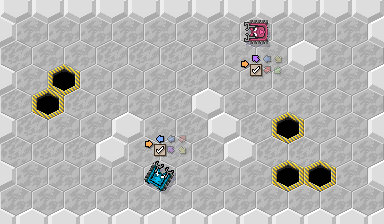
Nothing here is live. The next big step will be figuring out how to animate
both the UI and the robots in an elegant way. I don't want to maintain a lot
of state just for animations, so would like to figure out a general mechanism
for making objects transition "on the beat" of the global clock.
S5: Turn Order
------------------------------------------------------------------
In _RoboRally_, turns for players are taken in order of distance
from a central spot, and then all board elements activate.
I want the
game to feel almost like a rhythm game, with player turns happening at
a slow, steady cadence. So, I can't change the turn order between turns.
But I want board activations (especially conveyor belts) to feel consistent.
I can't simply run them _between_ players or they'd happen twice before players
have a chance to interact again (in 2 player mode), and if they run after
a specific player, then they would be biased in the turn order.
A solution for 2-player is to
say that the turn order is always:
1. P1
2. P1
3. Board
4. P2
5. P2
6. Board
This brings back the earlier notion of planning ahead a bit and using a "hand".
This could be extended to higher numbers of operations and players, but
the board is not very large and the strings of actions would get long and less casual.
I'll show the player two pairs of operations. They select each to
fill registers by the end of the selection time, and then these execute
and the next three come.
I also shifted the board by 1/2 a hex so that the minimal space is spent on boundary
hexes. For 32x32 hexes, I can fit 12x9 hexes fully on screen
at 384x224, with a visible boundary around them.
S6: Hex Math
------------------------------------------------------------------
I implemented the coordinate system mappings between pixels, hexes,
and map offset coords; as well as between screen/world-space angles
and hex-space angles; hex-snapping; and the hex-angle to hex-direction
function.
Robots can now be specified with a `hex_pos` and `hex_angle` and
the world-space values are computed from them every frame. This allows
the mechanics and animation space to be all hex and the world-space
coordinates used for rendering only.
I used https://www.redblobgames.com/grids/hexagons/ as a resource but
still had to do a lot of adjustment for my axes and pixel scaling.
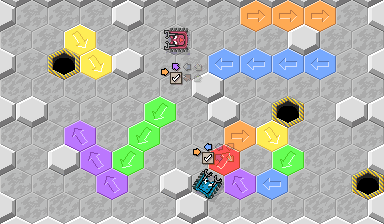
Currently at 76 statements, 0 sounds, 42k pixels
#### Theme Thoughts
I adopted a RoboRally theme to get started, but if the gameplay turns out
to be fun I think I want to move away from the industrial setting and combat goal.
I'm thinking about a pretty, nature-returns ruined city (ala _Last of Us_, _12 Monkeys_, _Crysis_).
The players are coop, slow real-time programming (slow-gramming!) mechs that have wonky broken controls
because they are old. The goal is to gather specific resources, rescue people, or solve problems
in each scene vignette. You come in on a train, run around a scene doing stuff,
and then get back on the train and ride it to the next scene. Also sort of Into The Breach feeling
in terms of small, pretty areas with diverse tasks, and being upbeat despite the depressing setting.
#### Turns
I considered a lot of different ways of handling turn taking. The challenges are:
- I want feeding a sequence of instructions to feel fairly smooth, splitting the difference
between real-time control and explicit turns with waiting. I don't want players to think too
far ahead and make the game too hardcore in a strategic direction. I don't want them to
move too quickly and have it degenerate into an arcade game with frustrating controls.
- Co-op gives more freedom for pacing, as I can balance the game "unfairly" in the players'
favor. It doesn't matter if the time between turns changes with the number of players or
the board as much because there's no competitive feel to throw off. It also doesn't matter
who goes first.
- Simultaneous motion would be ideal, but it creates lots of problems. What if one player
collides with another? Should players be able to move one immediately behind each other,
because there will be no collision if they move simultaneously? How does the board moving
players affect players moving themselves if it all happens at the same time? What if the
constraints form a cycle, such as players driving in a circle? Do I have to build a whole
constraint managements system just to lower latency between input and motion?
- I tested adjusting player rotation and translation speeds so that all animations would fit
within a single turn. It felt bad. It was like the character sped up or slowed down for no
reason.
- I want the time between a player's turns to be the same within a level, so that they can
get into a kind of rhythm. If NPCs and the board "take turns", then that will change
between levels. Do I have to reserve time for the board or NPCs each turn even when they
are doing nothing?
After thinking through a lot of alternatives, I decided to try the following, dead-simple solution
first:
- Player ACTIONS turn into one or more INSTRUCTIONS in a queue not visible to the player
- Rotating 60 degrees is a single INSTRUCTION. Moving one hex is a single instruction
- Everything takes turns. The order is randomized once per level. Players shouldn't feel
an "order" (and may not even notice the cycle), because they can provide input at any time
and it will queue for their next turn
- The board can't move players in normal circumstances, so it won't get a turn. Occasional
exceptional activities, such as a bridge collapsing, will happen on a character's turn
if triggered by that character and be injected between turns if they happen automatically
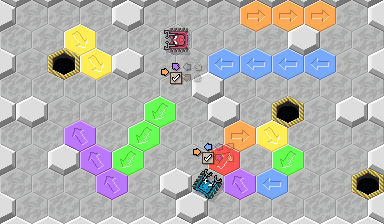 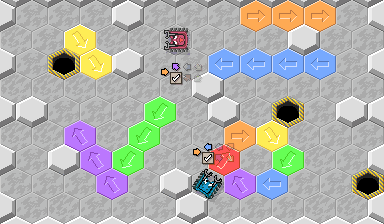
The above simulation shows that the velocity appears variable on the left
and constant on the right. I like the right better, which matches the new plan.
The only undesirable aspects are that the time between moves may be inconsistent across
levels and that depending on turn order, `A` can drive right behind `B` but `B` must be 2 hexes behind `A`.
I implemented the compilation of actions into instructions that run once per player
turn. There is still no checking of whether the actions are legal, and very little graphical
feedback of what is going on with the queues.
Now at 103 statements, 0 sounds, 42k pixels.
S7: Instructions
------------------------------------------------------------------
[x] Draw new nature-theme tiles
[x] Water
[x] Grass in concrete
[x] Grass
[x] Dirt
[x] "Compiling" actions to instructions
[x] Detect collisions with the map
[x] Playtest two player turn taking for feel
[x] Increase icons from 8x8 to 11x10 for better readability
Two players taking turns is ok. More players may feel stunted, like
there is too long of a wait between moves. Right now the main problem
is that there is too little strategy. I basically just choose whichever
direction isn't opposite my goal, hoping to eventually wander over there.
Instead there should be more strategy in the movement itself;
if there's an obvious algorithm for the "optimal" move it isn't interesting.
Some ideas:
- Given a sequence of _n_ moves, play _n_ - 1 of them in whatever
order is desired. This forces thinking a bit ahead in order to avoid
obstacles and burn undesired moves.
- Add more instructions that interact. For example a "2X" multiplier that
applies to the following instruction.
- Choose between *pairs* of moves instead of individual moves. I'm worried
that this still has a dominated strategy (choose the least bad pair) that
forces fully considering two short sequences.
- Play some completely different minigame to "construct" moves.
Imagine playing Tetris where different combinations of shapes formed
different directions.
Now at 108 statements, 0 sounds, 53k pixels.
 

S8: Hand
------------------------------------------------------------------
Implemented a "hand" of cards, where the player chooses the order
to execute them before being dealt a new hand. This leads to Dominion-like
play, where there's something to think about. The RoboRally-style bookkeeping
should be reduced by taking the actions immediately.
[x] New `player.action_array` data structure for the hand
[x] Draw hand
[x] Track horizontal position along the hand
[x] Implement executing actions
[x] Refill the hand when empty
[x] *Always* give a 0X modifier

Game size is 123 statements, 0 sounds, 53k pixels.
S9: Modifiers
------------------------------------------------------------------
[x] Make modifiers not count towards resetting the hand
[x] Draw active modifiers shifted up and yellow in the UI
[x] Implement modifier selection
[x] Change the `player.available_array` --> `player.status_array`
[x] Values are `"on"`, `"off"`, and `"used"` for modifiers and `"available"` and `"used"` for other actions
[x] Allow modifiers to be selected and unselected
[x] Apply the modifiers to action compilation
[x] Wipe the active modifers after an action
[x] Add 4-player
[x] Visually connect each player character to their UI
[x] Implement horizontal shifting of the UI to always
remain visible
[x] Shift UI to remain visible when other players are nearby
[x] Add optional UI on screen edges
 
Game size is 184 statements, 0 sounds, 63k pixels
S10: 2P playtest
------------------------------------------------------------------
[x] Prevent robots from hitting each other
[x] Generalize actions to entities from players
[x] Playtest moving in multiplayer with both UI setups
Playtest feedback:
- Players confused about modifiers and actions
- Colors don't match other quadplay player colors
- Turn taking is annoying when everyone is moving
- On robot UI is generally byt not universally preferred
Playtest followup:
[x] Make the first turn have no modifiers so that they learn how to
move without constraints or modifiers
[x] Make the colors match the unofficial/implicit quadplay color order:
pink -> blue -> yellow -> green
[x] Per-player choice of UI on robot or at the bottom
[x] Help text on first turn
[x] Start robots from the initial position on the right (this will be the train)
[x] Make a visual indicator that instructions are still pending
[x] Allow all entitys that can't interfere with each other to move simultaneously
Now at 218 statements, 0 sounds, 102k pixels
S11: Conveyor Belts
------------------------------------------------------------------
Now my goal is to ensure that basic movement is engaging for everyone.
If moving the characters around is achievable without frustratio but
still challenging enough to be interesting, then I can add puzzles as
the next larger reward cycle and it will enhance the game.
Further playtest feedback:
- Just competitive racing is fun (or would be with handicaps)
- First turn instructions are too abbreviated to understand
- Playtesters want a colored border or colorwheel to help make the
color mapping clearer (even though it is redundant with the arrows)
[x] Make a race map
[x] Draw a goal hex
[x] Reduce color on conveyor belts
[x] Implement conveyor belts:
[x] At the start of a player's turn on a conveyor belt:
- `if not (player.instruction_queue[0] default {}).is_conveyor and not (player.instruction_queue[1] default {}).is_conveyor`, insert a conveyor instruction after instruction 0 (or at 0 if there is no other instruction)
[x] Draw animations
[x] Add animation support to map drawing

Game size is now 242 statements, 0 sounds, 147k pixels.
Runtime cost is low (MacBook Pro): Framerate 60Hz (1×); **4.2ms Total** = 1.8ms CPU + 0.0ms Phys + 2.4ms GPU
S12: Handicaps
------------------------------------------------------------------
Add handicaps:
[x] Allow different per-player handicaps
[x] Level 1: Guaranteed -1x and a 0x every round
[x] Level 2: Guaranteed two modifiers and four directions, no repeats on directions
[x] Level 3: Current algorithm. Guarantee at least 3 directions and at least one modifier.
[x] Title screen
I've been playtesting up to three players (I don't have four available right now)
in race mode and the game seems viable. I've flushed and fixed a few bugs but there are
no major complaints any more about the UI or controls...mostly the players
want handicaps (just added) and new maps.
I changed from the working title of "Slowbots" to "Out of Control" as
a real title.
Game size is now 294 statements, 0 sounds, 310k pixels
S14: UI Cleanup
------------------------------------------------------------------
I changed the name to "Beyond Control". I think "Beyond" is stronger and
more unique than "Out of" and better evokes exploration and a (pretty)
post-apocalyptic world.
[x] Implement shorting out in water by taking away slots
[x] Colored border on main screen
[x] Make robot appear underwater
[x] Make water only short one spot at lowest difficulty
[x] Make game selection screen:
- Race
- Battle
- Quest
[x] Persist difficulty levels
[x] End game detection and menu
Playtest feedback:
- Water makes sense and is fun
- Difficulty levels work
- Advanced players want more modifiers. Ideas:
- "Forward" arrow that goes whatever direction you're facing at the time it executes. Maybe make the icon
itself rotate based on the `final_hex_angle` so that it is a little easier to use
- "Turn" modifiers that rotate the direction of regular arrows


Game size is now 429 statements, 1 sounds, 561k pixels.
S14: Race Maps
------------------------------------------------------------------
[x] Multiple maps
[x] Make four race maps total
[x] Implement minimap rendering
[x] Implement race map selection UI
[x] Shuffle spawns
[x] Redraw title screen for better theming
[x] Redraw tiles for stronger visual contrast and clearer conveyor motion
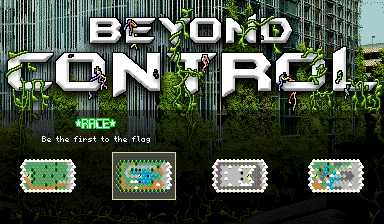 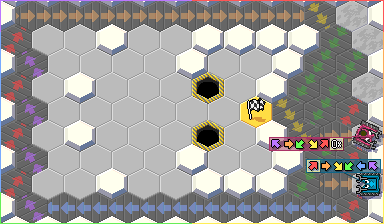 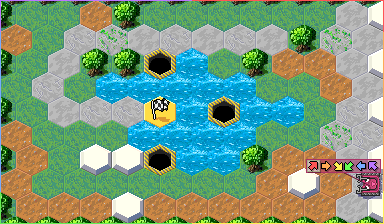
Game size is 450 statements, 1 sounds, 735k pixels.
S15: New Race Maps
------------------------------------------------------------------
[x] Arbitrary spawn locations in race mode
[x] Update the lowest difficulty to start with directions
towards the center of the screen (i.e., away from the
initial spawn)
[x] Map scrolling for more than 4 maps
[x] Draw overgrown wall hexes
The current set of race maps:
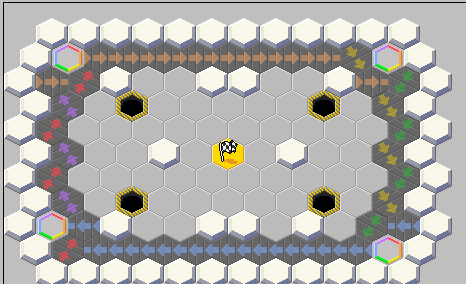 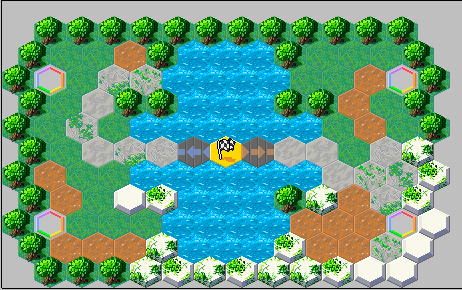 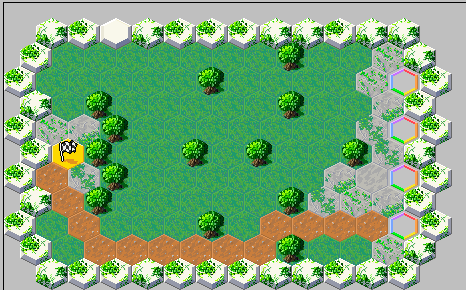
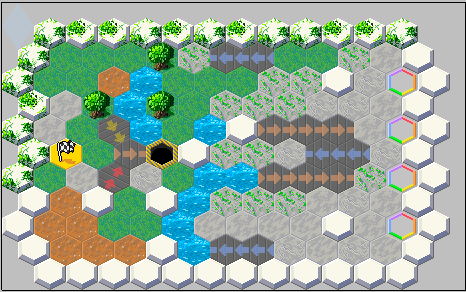 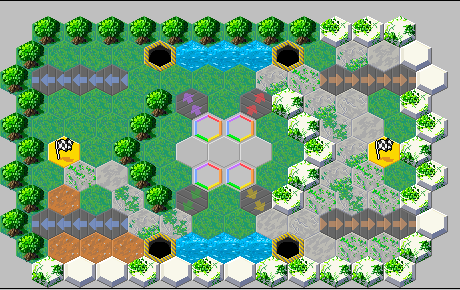
Game size is now 470 statements, 1 sounds, 809k pixels.
S16: Polish and Bug Fixing
------------------------------------------------------------------
[x] Per-player sounds
[x] Robot movement
[x] UI change
[x] UI accept
[ ] UI cancel
[x] Title music
[x] Make the `CompetitiveWin` menu use a cursor just like the other menus
[x] Make level 2 difficulty (appears as 3 in the game) slightly harder
by only guaranteeing one instead of two modifiers
[x] Make level 3 difficulty slightly harder by lowering the environmental
recovery rate
I expected to playtest for the new map layouts. But
the playtest flushed a number of bugs that only occur in
multiplayer or after completing and then restarting a map.
The "Rematch" option currently causes the previous player to
immediately win on the same map (or maybe any map with the
flag in the same position?)
On loading a new map, the conveyor belts and blockers do not work
consistently.
...the bug turned out to be not clearing the `entity_array` on game
start. The `entity_array` has the contents of the `player_array` as well
as any NPCs (which don't yet exist), and I forgot to erase it.
More playtest results:
- New bug with conveyor belts, where sometimes players
who move on them can get into a state where the conveyor never tries
to move them again.
- Placeholder UI sounds aren't too annoying, although they should be upgraded
- New graphics are an improvement
- Higher difficulty levels need to be even harder
- A player found a new strategy of intentionally driving into water to short out
registers with bad instructions. (I hadn't anticipated this, but want to encourage
it! I'll make another kind of short that kills other instructions.)
- Need more, harder maps with more interaction opportunities
- Easy difficulty levels are great...they really are a huge advantage and are relatively
fast
S17: Fire
------------------------------------------------------------------
[x] Draw an animated fire hex
[x] Refactor "wet" code to handle both hot and wet as a generic
environment damage routine. Rename the fields consistently on
`player`, `ASSETS`, etc. so that "hot" and "wet" can be used everywhere
instead of "fire", "water", "wetness", etc.
[x] Make a fire "short" that fries the *first* two
instructions, as the inverse of the wetness short
[x] Make wetness instantly remove heat
[x] Make fire animation for robot
[x] Make fire instantly remove wetness
[x] Make fire sound
S18: Conveyor Bugfixing
------------------------------------------------------------------
The forward instruction proved remarkably simple to implement.
To draw it in the UI, I just substitute a rotated sprite where I round
the `future_hex_angle` to the nearest 45 degrees. That automatically snaps
60 degrees to 45 degrees. To compile it, I just issue a `MOV` instruction
on the robot, which is already a relative motion--the absolute motion
is produced by extra `ROT` instructions, which I just ignore in this case.
I'm looking for the conveyor belt bug. It seems that in some situations the
conveyor affects the robot one turn after it has moved on, and in
other situations it ignores the robot altogether.
...
The delayed conveyor belt bug was caused by having a 2-hex direction
specified for the southwest direction instead of a 1-hex value.
I haven't been able to reproduce the other conveyor bug. I debugged this
by printing all of the state in the conveyor belt logic right when it
executes.
[x] Add rainbow "forward" arrow at highest and second highest difficulty
[x] Animate forward arrow rotation to make more obvious that it is changing
[x] Fix conveyor belt bug
[x] Make the title screen spark and pulse on the beat
S19: Max Difficulty
------------------------------------------------------------------
I've been tweaking graphics and fixing bugs primarily during
this session, but added a few features that were long planned and
only needed a few lines of code each.
[x] Make an intro for the race map to help players know which robot is theirs
[x] Add rotation direction modifiers at highest difficulty
[x] Show titles & descriptions of maps on selection screen

Game size is now 576 statements, 10 sounds, 367k pixels.
Previous pixel counts were incorrect due to a double-counting bug
in the resource stats that is now fixed.
S20: Battle Design
------------------------------------------------------------------
Design ideas for Battle and Quest games:
- Flame thrower and LN2 spray
- Add new *modifiers* (not instructions)
- Allows them to be held
- Forces movement to continue attacking
- Need to randomize the difficulty 0 modifier when armed
- Flame thrower turns ice to water and trees to fire
- LN2 turns water to ice and fire to dirt
- Holding still for too long will glitch robot, randomizing the hand...prevent battle standoffs and spawn camping or getting stuck in quest mode
- Water protects from flame thrower
- 2-4 hex range
- Both weapons insta-kill other robots
[x] Implement pits
[x] `player.enabled` state that can be used to temporarily
hide a player and prevent UI
[x] Store spawn location at map start
[x] Color spawn locations using `draw_poly(..., player.color)` so that
players will know where they're going to teleport back to
[x] Animate falling down the pit with `sequence()`
[x] Sound effect
[x] Draw additional broken and overgrown pavement tiles
Game size is now 614 statements, 11 sounds, 394k pixels.
I note that the game has increased about 3x in "size" since
it was first playable, which means that 2/3 of the assets and
code are polish rather than core mechanics.
S21: Sprint
------------------------------------------------------------------
I'm now trying to wrap up the game in a complete state in order to
consider it done. I'm hitting the end of the virtual 3-day
jam timeframe (20 sessions x 90-120 min = 30-40 hours of development),
and GMTK 2020 would have given me about that much development time
had I been in a position to do it all at once instead of a short period
each day due to my schedule this year.
The biggest concession to time is that I've cut Quest mode, although I
hope to return to it in the future for polish. I'd very much like to redo
most of the in-game art or connect with a real pixel artist for that, which
would be another good post-completion polish pass.


New in this session:
[x] Move modifiers to the _front_ registers in restocking to make it
more intuitive that flame thrower and LN2 will go first
[x] Make fire lock the _rear_ registers
[x] Draw abandoned car hex
[x] Draw building ruin hex
[x] Hide quest mode in the menu
[x] Fix "Battle" not appearing in the game select menu
(I was confusing `continue` and `break` in a loop)
[x] Draw ice tiles with animation
[x] Visuals for burn and freeze
[x] Make `SPRAY_RANGE` constant
[x] Make interference detection account for spraying:
within `SPRAY_RANGE` for movement and spraying, and within `2 SPRAY_RANGE` for both spraying
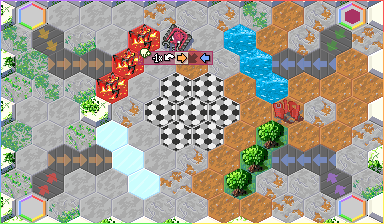
Game size is now 641 statements, 11 sounds, 396k pixels.
S22: Battle Testing
------------------------------------------------------------------
Battle mode was a little too hard. I found myself trying to waste all of the
actions to get another attack modifier. I increased the chance of an attack
modifier to 100%, but it still wasn't enough (especially because there are TWO
types, and sometimes you get one that you can't use in that situation).
This still wasn't enough. So, I made the attack modifiers replace a move action
instead of a modifier. This increases the chance of being able to do something
useful because eliminating moves decreases the time until a new set of moves is
available. I also increased the width and length of the cone (by accident, although
it seems like a good idea if weapons are underpowered).
I'm now switching the weapon to the _last_ slot instead of the first
and making it fire after the move instead of before. This resolves
the issue of whether you can use attacks in water: you can't, because you lose
that slot.
If this is still too hard, then I might have to either extend the hand size
or have weapon modifiers restock themselves rather than waiting for a new set
of actions.
...
After playtesting, it is still too hard to use weapons and move in battle mode.
In response, I gave all players the low-difficulty set of starting moves (which are
towards the center of the board) in battle mode and made the weapon modifier
automatically restock every 32 turns even if the actions aren't all used.
This is about once every 8 seconds. I suspect that I'm going to have to increase
the hand limit to 7 in battle mode, but I'm going to playtest more first
because that requires touching a lot of code.
Bugs:
[x] Fix: Players can currently execute an already-used action
and waste a modifier on it. This was caused by allowing used
actions to fall through the button press instead of stopping it.
[x] Fix: Rotation modifiers sometimes get stuck on, even once consumed.
This was caused by forward arrows, not rotation modifiers--they were
not updating the `future_hex_angle` because they were compiled
separately.
[x] Fix: Environment sounds playing twice. They were triggered by the `end_map_sprite`
instead of the `current_map_sprite`, which meant that they were detected
before the actal state was set.
New Features
[x] Implement battle mode
[x] Scoring and visualization
[x] Win
[x] Stop spray at map blockers
[x] Burn map
[x] Freeze map
S23: Tuning Weapons
------------------------------------------------------------------
Make weapons fire both before AND after movement/turn. This makes them
easier to use and increases chaos. I reduced the `SPRAY_RANGE` by 1
because this would otherwise allow one attack to cover about 1/4 of the entire
map of hexes due to the rotation in between.
[x] Fix: future_hex_angle gets out of sync still. I didn't have
a consistently reproducible test case, but I wrapped a lot of assignments
in angle wrapping code and it hasn't happened in a while.
[x] Fix: Not getting a guaranteed reverse as intended every move.
[x] Increase hand size in battle mode to 7
[x] Switch the attack modifier to slot 0 and the guaranteed
reverse to slot 1, shifting the other modifiers
[x] Burn entities
[x] Freeze entities
Battle mode is now feature complete...the game is feature complete!
Game size is 719 statements, 16 sounds, 606k pixels.
S24: Polish
------------------------------------------------------------------
[x] Fix fire not melting ice (ice wasn't flagged with `can_melt` in the sprite.json!)
[x] Draw damage on robots
[x] Make robots have more unique shapes
[x] Sparks from the robots when they move
[x] Remove unused spawn tiles to generic 0,0 sprite
[x] Battle mode score animation and sound
[x] Flash bar when scoring
[x] Animate stars when scoring
[x] Play powerup or coin sound when scoring
[x] Burn spray sound (flame thrower)
[x] Freeze spray sound (fire extinguisher)
[x] Remove debugging/assertions around `future_hex_angle`
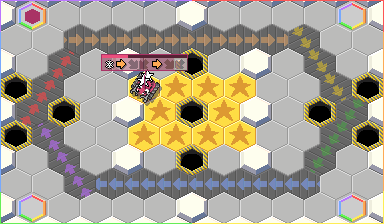

Game size is 747 statements, 20 sounds, 606k pixels.
S25: Battle Map Tuning
------------------------------------------------------------------
During battle map playtesting we found that for 2-player battles it
is very important to have a short distance from spawn to end zone in order
to keep players engaged with each other. We moved the end zone closer to
the spawns and added more conveyor belts in most maps to enhance this.
We also added a few more specific blocking walls to protect spawns,
and removed some to make it easier to reach the end zone.
Players wanted a faster way to input on battle mode, so I made the cursor
wrap around the action bar.
To prevent turtling on the endzone in battle mode and help with handicapping,
we changed the scoring to only awarding points when the player moves onto
a goal square rather than the entire time the player is there. This forces
a player in the end zone to keep moving. We made the amount of points awarded
per move scale up as difficulty goes down, so that less-good players have
an advantage.
During playtesting we tuned the base score per move down from 15% to 5%, which
seemed good for level 4 and 5 players.
[x] Show map title on the win screen
[x] Make cursor wrap around
[x] Fix: Instructions are not being wiped when players die and
it can cause players to drive off the map. Use an epoch
counter to ensure that a delayed instruction occurs during
the same spawn epoch that it was issued in
[x] After respawning, give the initial instruction hand instead
of random ones
[x] Make players in battle mode have to move to continue scoring
[x] Animate teleportation
Game size is now 767 statements, 19 sounds, 606k pixels
S26: More Polish
------------------------------------------------------------------
[x] Add cosmetic smoke coming from robots
[x] Increase sparks, to every action
[x] Add ambient sounds to maps
[x] Yellow robot's color is being read as white due to new damage sprites...change the sprite pixels
[x] Fix: After death and respawn, player entities have the wrong
angle. All angle state is being reset in and the epoch
counter _should_ prevent any async callbacks from changing
it after teleportation, but the robot still thinks it is on the wrong
angle after teleport. (Solution: I've patched this many times, but each
patch refactored and appears to have missed something different.
this time, the angles were all reset, but the instruction queue wasn't
erased. Fixed...*again*)
[x] Add teleport sound
[ ] Make preview.png image
[ ] ~~Improve first turn instructions:~~
[ ] ~~Show arrow instructions until three movements~~
[ ] ~~Then show (a) until three actions~~
[ ] ~~Show (d) for the next turn~~
[ ] ~~Animate flag sprite~~
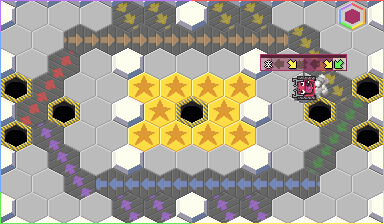
I made another pass over the code. I removed about 20 statements through
abstraction and IDE constants, and removed vestigial debugging paths.
Another 20 statements
can be removed by moving the entire "vapor" sprite particle system into
the quadplay general particle system script. I don't plan to do that right
now because it will involve refactoring other games that use it,
but I think it would be a great way to expand the utility of that system
in the near future.
Game size is 764 statements, 25 sounds, 606k pixels.
]("https://github.com/morgan3d/quadplay/blob/master/sprites/blasphemer-tiles-64x64.png?raw=true")
_This is the design document for a game jam Shmuel and I wrote in [quadplay✜](https://github.com/morgan3d/quadplay) with one of my children
over two months. I share my design docs and change logs to help demonstrate process for folks learning
game and software development.
[**Play the final version online**](https://morgan3d.github.io/quadplay/console/quadplay.html?game=quad://games/beyond_control/).
It is best with multiple players and controllers._
**Setting**: Broken-down mechs in a world reclaimed by nature
**Pitch**: RoboRally meets Dominion
**Goal**: Race and battle
**Mechanics**: Real-time, turn-based programming: moving is a puzzle and every second is a potential turn
**Influences**:
- "Out of Control" GMTK2020 jam prompt
- _RoboRally_ movement and broken registers
- _Dominion_/_Magic_ tactical choices
- _Into the Breach_ / _Crysis_ / _The Last of Us_ aesthetics
Reward Cycles
==================================================================
From smallest to largest:
1. Solve the puzzle of combining six operations to move the robot a small distance (~30 sec cycle)
2. Strategically traverse the map, using features to accelerate and shield the robot (~1 min)
3. Complete quest objectives or race and battle challenges per map (~3 min)
4. High score streaks and quest progress, raising difficulty to access more complex instructions (~15 min)
Mechanics
==================================================================
Each player has an `instruction_queue` of instructions to execute.
All instructions take "1 turn" = `INSTRUCTION_FRAMES`. The player
also tracks the `future_hex_angle` that it will be at after the
queue has completed. This is used to compile absolute ACTIONs into
relative rotation INSTRUCTIONs, where the ACTIONs can be compiled at
any point.
All UI only ever requires horizontal input and a single button, including
menus.
Turn Based
------------------------------------------------------------------
Although it feels slow real-time, the game is entirely turn based.
This keeps the mechanics simple and makes it fair.
The real-time feel comes from several key design decisions:
1. Players can put more instructions into their queue at any time
2. Entities that can't interfere with each other can take turns
simultaneously,
3. Rotation instructions are the most common and are uninterruptible
4. Thinking about a move and using the UI take about the amount of
time between turns.
The hex-based movement and "real-time" turn-based gameplay are elements
that I definitely want to re-use in future games. They're a great
way to bring board game ideas into an arcade video game.
Target duration is 10s-1min from launch to actual gameplay, 4 minutes
of play for a race game, and 6 minutes of play for a battle game.
Actions
------------------------------------------------------------------
Action | Compiles To
------------|--------------------
Movement | `ROT` and `MOV`
0x, -1x, 2x | Changes the number of `MOV` instructions
Spin arrow | Changes the number of `ROT` instructions
Forward arrow | `MOV` in the current direction
Burn | `SPRAY`
Freeze | `SPRAY`
Instructions
------------------------------------------------------------------
Instruction | `op` | Parameters | Notes
---------------|---------|-----------------|---------------------------------------------
Rotate | `ROT` | `sign : +/- 1` |
Translate | `MOV` | `sign : +/- 1` | Assumes current direction, plays motor sound. Blockable
Conveyor | `CON` | _none_ | No motor sound. Blockable
Spray | `SPRAY` | `type`: `action_sprite.burn` or `freeze` |
Difficulty Levels
------------------------------------------------------------------
Level| First turn | Reduced duplicates? | Modifiers | Instructions | Evt. Penalty | Evt. Recovery | Score Handicap
-----|-----------------|---------------------|--------------|------------------------------------------------|--------------|---------------|---------
0 | Away from spawn | Yes | 2 (0x & -1x) | Cardinals, 0x, -1x, 2x | 1 reg | 10% | +200%
1 | *Cardinals* | Yes | *2 random* | Cardinals, 0x, -1x, 2x | *2 reg* | 10% | +150%
2 | Cardinals | Yes | *1-3 random* | Cardinals, 0x, -1x, 2x | 2 reg | 10% | +100%
3 | Cardinals | *No* | *0-3* random | Cardinals, 0x, -1x, 2x, *forward* | 2 reg | *5%* | +50%
4 | Cardinals | No | 0-3 random | Cardinals, 0x, -1x, 2x, forward, *rotate mods* | 2 reg | 5% | +0%
The specific registers affected by environmental damage are
predictable so that players can plan around them. Water damages
the two (or 1 for level 0) central registers. Fire damages the
leftmost two (or 1 for level 0) registers.
Coordinate System
==================================================================
"Pointy-up" hexes with directions northeast, east, southeast, southwest,
west, and northwest. 32x32 tiles, where due to shifting each offset row
is 24 pixels above its predecessor. Cheat the perspective to use 2:1 slopes
on the diagonals of the hex. Borders abut unstead of overlapping. Allows
exactly fitting the 384x224 screen and easy coordinate transformations, compatible
with Tiled TMX maps as well.
Most of the game runs in hex coordinates using the axial method and
`xy()` representation.
The world-space pixel `(0, 0)` is at the lower-left of the screen,
which corresponds to the center of a hex in the last row of the map.
The coordinate system math and hex map rendering is in
[`hex_grid.pyxl`](https://github.com/morgan3d/quadplay/blob/master/games/beyond_control/hex_grid.pyxl).
Post Analysis
==================================================================
Reflecting on the game at this point: _Beyond Control_ is now feature complete and
"done" from a game jam perspective. I cut the Quest game type for now. Battle and
Race are fully implemented and have been playtested a bit.
It needs a ton of polish on art, sound effects, and especially UI animations. I came
in around the time limit that I was looking for of "three day jam", but it was spread
over three-plus weeks because of extenuating circumstances and schedules that prevented
me from actually coding very long on any given day.
The scope is kind of aggressive for a jam game at my desired level of completion, but it
worked. I'm very happy that I succeeded in my primary goal, which was making _RoboRally_
more fun and intuitive for players like me who can't deal with either its pacing or the
rotation confusion.
The secondary goals of making a video game that works like a real-time boardgame
mechanically and that uses hex grids were also achieved. The in-game atmosphere in sound
and visuals don't live up to my goals of "city ruins uplifitingly reclaimed by nature", although
the title screen does deliver that acceptably. It satisfies the "out of control" GMTK'20
prompt fully and more-or-less makes that partial loss of control an interesting puzzle instead
of a frustration.
I rate this game a solid B for an experienced developer's jam game, where I think our
previous Ludum Dare _Across the Lake_ was an A.
Quadplay made this game possible. I don't think I could have achieved it within the time
constraints using any other engine right now. The transition to hex coordinates worked
extremely well because the quadplay resolution and math libraries anticipated alternative
schemes. Having Tiled as a map editor made it easy to create lots of maps.
Built-in sprite rotation and scaling were great, and there was plenty of performance for me to just
brute force the graphics and computation. I never optimized anything except the core hex
routines. That wasn't even necessary; it was anticipating future reuse. The map preview rendering is all handled with the camera feature and greatly simplified
the minimap "icons". I thought I was going to have to offline generate the minimap images
by hand, and instead I just brute force rendered multiple maps with extreme zoom at runtime
and it worked.
I used quadplay's `delay()`, `sequence()`, and mode features heavily for animation and UI.
They made it really simple to do things that could have required lots of ugly, buggy code.
This was a big deal and enabled me for the first time to do a lot of UI and UI animation
for a jam game.
I was bitten by checking in the `DEBUG` flag and other debugging options a few times. That
happens on every jam. The upcoming debug constant layer for quadplay will address this
and I can't wait to have that. I used the new CSV file import and in-IDE sprite JSON editing.
The CSV import was convienient, although I could have used JSON or a code generator if
needed. The sprite JSON editing is still not fully supported in quadplay's IDE. It was
just good enough to use, but the 1.0 version will be very welcome. IDE search-and-replace in
files will be handy. I fell back to using `grep` and emacs during some refactoring at the end.
So, no new engine or IDE feature requests from this game, for the first time...just eager
anticipation of the 1.0 features already on the quadplay roadmap.
In terms of workflow, even with diminished resources my standard practice of journaling and
maintaining a bare-bones game design doc worked well. Actually, it helped a lot with
diminished resources because I was able to do most of the design work "offline" and didn't
have to spend much cognition remembering or planning while programming. I put a lot more
into the quadplay `todo()` system than the design doc for actual TODO lists and that was
both effective and motivating.
Photoshop + Audacity + ImageOptim + Tiled were fine tools as always and interacted well
with the IDE. git was adequate in this case and I never got bitten by anything with it,
probably because there were only two of us.
I should have chosen a single area of focus instead of two. I had an aggressive
gameplay/mechanic idea _and_ a strong thematic vision. Because I ultimately had to
choose between them, I executed on the
gameplay but did not succeed with the theme. It would have been better to adopt existing
assets almost entirely (although good hex assets are tough to find) or use an abstract
theme instead of splitting my efforts over two areas. Or, if I had teamed up with someone
working exclusively on sound and art, then maybe it would have been viable to try and excel
in two areas at once.
The scope was a little large for a jam. I think I should pull back more next time.
I'm not going to beat myself up over it because I wanted something a little
less casual and did pull that off. But more casual and then polished as a result definitely leaves
me more satisfied at the end of a jam (hence my "Casual + Effects" handle.)
In terms of positioning for a jam game, this is acceptable, but not great. It can be
played in a browser, supports single player, and requires no backstory or instructions.
Those are all good. But it takes 15 minutes to really appreciate and is best with two
or more players. An ideal jam game could be appreciated in 5 minutes with a single player.
Special thanks to the quadplay community for support and suggestions,
and especially Stephan Steinbach for suggesting the UI design pattern
and axial hex coordinates.
The game size is 728 statements, 16 sounds, and 606k pixels.
"Statements" in quadplay are a reasonable measure of code complexity
that excludes comments and standard libraries, collapses multi-line expressions,
and excludes some syntax such as function definition and local scope lines.
Pixels include font sheets.
Change Log
==================================================================
Each session is 90-120 min of programming or art. Time spent
thinking about the design and documenting it between sessions is
not recorded.
S1: Original design
------------------------------------------------------------------
**Working Title**: "Slowbots"
**Setting**: Robot factory floor battle arena.
**Pitch**: Roborally meets Gloomhaven.
**Goal**: Be the last robot standing.
**Mechanic**: Real-time turn based programming: every 1s is a potential turn.
You have a hand of two cards, each with one symbol on the
top and one symbol the bottom (like Gloomhaven).
Symbols are move, rotate left, rotate right, shoot, push
button, etc.
Your actions:
1. Queue the top symbols from both cards for your robot to execute, and then draw two new ones
2. Queue the bottom symbols from both cards for your robot to execute, and then draw two new ones
3. Swap the order of the two cards
When you've played your deck, they reshuffle.
You can pick up new cards in the arena (like Dominion, use this for deck control).
There are bridges, pits, conveyor belts, lasers, etc. on the factory floor.
(At least, I think that Gloomhaven has the cards with two actions mechanic.)

S2: Simplify
------------------------------------------------------------------
New design: "[RoboRally](https://boardgamegeek.com/boardgame/18/roborally) meets puzzle swapping".
- There are top and bottom streams of actions, represented by icons.
- The player chooses either the top or bottom element for each pair,
and then executes it. Execution always happens on a regular, slow clock.
- If the player stalls too long, then the robot "reboots" and both
streams completely reset. This is to prevent a player from spawn camping
or reaching a standoff by just holding still.
The icons for actions rotate to match the alignment that they will be
in if this stream is chosen. They are also colored to provide some
consistency while they're rotating and help make them readable.
I've implemented the UI for this, including the relative rotation of upcoming
actions in the stream.
The advantage of a design that uses *rotate actions* is that they make the
move actions frequently useful (e.g., if you're trying to go to the left,
then you can usually avoid being forced to ever choose to turn 180 from your
desired path, although you might wiggle a lot). The disadvantage is that they make all
following actions relative. That requires extra animation and is a lot harder for
the player to think about than absolute directions. I suspect that I'll end up
using absolute directions to simplify further.
  
S3: Simplify More
------------------------------------------------------------------
I've switched to absolute directions now to
simplify the implementation and UI by removing all of the
icon rotation.
I initially made square grid absolute movements, but then realized
that a hexgrid helps reduce the "most absolute directions are not the way I want to go"
problem. (I'm always eager for an excuse to use a hex grid, because it looks cool.)
With four cardinal directions, 25% of the directions have a dot product that is
positive with a desired direction. With _six_ cardinal directions, 50% of the directions
have a positive dot product. This doubles the chance that the player can move in a direction
that they want to (roughly). Because players will always have the choice of _two_ directions,
this increases the chance of moving in a desired
direction from (100% - 75%^2) = 43% with a square grid
to (100% - 50%^2) = 75% with a hex grid.
In switching to hex icons, I removed the borders (which got large and ugly as hexagons)
and changed to colored icons with black borders. This gives a distinctive silhouette and color
to each icon, as well as making them smaller, so it has several graphical advantages.
  
At 32x32 with 2:1 slopes on the diagonals, point-up hexagons look better to me than
point-sideways ones (with 1:1 slopes on the diagonals, point-sideways looks better).
So, I'm rotating my icons 90 degrees.
For the actual game tiles, there are two ways to draw hex tile as
pixel art. If the borders will fit together and _overlap_ outlines,
then 3-pixel points at 31x32 pixels make the right shape. If the tiles
will be adjacent without overlap, then 32x32 tiles with 2-pixel points
(where each offset row is 24 pixels high) are the right shape. This
works particularly well when the borders are either shaded or there are
no borders, and provides an integer tiling of the quadplay screen.
 
S4: Graphics
------------------------------------------------------------------
I drew two robots and some hexagons, and wired up the basics of
a static graphics display. Tiled can handle hexagonal maps with a little
bit of tweaking, and while quadplay can't run the optimized map rendering
with them, it can still handle this simple scene in 1.8ms (on a MacBook Pro),
so I think I can get away with the explicit map rendering.

Nothing here is live. The next big step will be figuring out how to animate
both the UI and the robots in an elegant way. I don't want to maintain a lot
of state just for animations, so would like to figure out a general mechanism
for making objects transition "on the beat" of the global clock.
S5: Turn Order
------------------------------------------------------------------
In _RoboRally_, turns for players are taken in order of distance
from a central spot, and then all board elements activate.
I want the
game to feel almost like a rhythm game, with player turns happening at
a slow, steady cadence. So, I can't change the turn order between turns.
But I want board activations (especially conveyor belts) to feel consistent.
I can't simply run them _between_ players or they'd happen twice before players
have a chance to interact again (in 2 player mode), and if they run after
a specific player, then they would be biased in the turn order.
A solution for 2-player is to
say that the turn order is always:
1. P1
2. P1
3. Board
4. P2
5. P2
6. Board
This brings back the earlier notion of planning ahead a bit and using a "hand".
This could be extended to higher numbers of operations and players, but
the board is not very large and the strings of actions would get long and less casual.
I'll show the player two pairs of operations. They select each to
fill registers by the end of the selection time, and then these execute
and the next three come.
I also shifted the board by 1/2 a hex so that the minimal space is spent on boundary
hexes. For 32x32 hexes, I can fit 12x9 hexes fully on screen
at 384x224, with a visible boundary around them.
S6: Hex Math
------------------------------------------------------------------
I implemented the coordinate system mappings between pixels, hexes,
and map offset coords; as well as between screen/world-space angles
and hex-space angles; hex-snapping; and the hex-angle to hex-direction
function.
Robots can now be specified with a `hex_pos` and `hex_angle` and
the world-space values are computed from them every frame. This allows
the mechanics and animation space to be all hex and the world-space
coordinates used for rendering only.
I used https://www.redblobgames.com/grids/hexagons/ as a resource but
still had to do a lot of adjustment for my axes and pixel scaling.

Currently at 76 statements, 0 sounds, 42k pixels
#### Theme Thoughts
I adopted a RoboRally theme to get started, but if the gameplay turns out
to be fun I think I want to move away from the industrial setting and combat goal.
I'm thinking about a pretty, nature-returns ruined city (ala _Last of Us_, _12 Monkeys_, _Crysis_).
The players are coop, slow real-time programming (slow-gramming!) mechs that have wonky broken controls
because they are old. The goal is to gather specific resources, rescue people, or solve problems
in each scene vignette. You come in on a train, run around a scene doing stuff,
and then get back on the train and ride it to the next scene. Also sort of Into The Breach feeling
in terms of small, pretty areas with diverse tasks, and being upbeat despite the depressing setting.
#### Turns
I considered a lot of different ways of handling turn taking. The challenges are:
- I want feeding a sequence of instructions to feel fairly smooth, splitting the difference
between real-time control and explicit turns with waiting. I don't want players to think too
far ahead and make the game too hardcore in a strategic direction. I don't want them to
move too quickly and have it degenerate into an arcade game with frustrating controls.
- Co-op gives more freedom for pacing, as I can balance the game "unfairly" in the players'
favor. It doesn't matter if the time between turns changes with the number of players or
the board as much because there's no competitive feel to throw off. It also doesn't matter
who goes first.
- Simultaneous motion would be ideal, but it creates lots of problems. What if one player
collides with another? Should players be able to move one immediately behind each other,
because there will be no collision if they move simultaneously? How does the board moving
players affect players moving themselves if it all happens at the same time? What if the
constraints form a cycle, such as players driving in a circle? Do I have to build a whole
constraint managements system just to lower latency between input and motion?
- I tested adjusting player rotation and translation speeds so that all animations would fit
within a single turn. It felt bad. It was like the character sped up or slowed down for no
reason.
- I want the time between a player's turns to be the same within a level, so that they can
get into a kind of rhythm. If NPCs and the board "take turns", then that will change
between levels. Do I have to reserve time for the board or NPCs each turn even when they
are doing nothing?
After thinking through a lot of alternatives, I decided to try the following, dead-simple solution
first:
- Player ACTIONS turn into one or more INSTRUCTIONS in a queue not visible to the player
- Rotating 60 degrees is a single INSTRUCTION. Moving one hex is a single instruction
- Everything takes turns. The order is randomized once per level. Players shouldn't feel
an "order" (and may not even notice the cycle), because they can provide input at any time
and it will queue for their next turn
- The board can't move players in normal circumstances, so it won't get a turn. Occasional
exceptional activities, such as a bridge collapsing, will happen on a character's turn
if triggered by that character and be injected between turns if they happen automatically
 
The above simulation shows that the velocity appears variable on the left
and constant on the right. I like the right better, which matches the new plan.
The only undesirable aspects are that the time between moves may be inconsistent across
levels and that depending on turn order, `A` can drive right behind `B` but `B` must be 2 hexes behind `A`.
I implemented the compilation of actions into instructions that run once per player
turn. There is still no checking of whether the actions are legal, and very little graphical
feedback of what is going on with the queues.
Now at 103 statements, 0 sounds, 42k pixels.
S7: Instructions
------------------------------------------------------------------
[x] Draw new nature-theme tiles
[x] Water
[x] Grass in concrete
[x] Grass
[x] Dirt
[x] "Compiling" actions to instructions
[x] Detect collisions with the map
[x] Playtest two player turn taking for feel
[x] Increase icons from 8x8 to 11x10 for better readability
Two players taking turns is ok. More players may feel stunted, like
there is too long of a wait between moves. Right now the main problem
is that there is too little strategy. I basically just choose whichever
direction isn't opposite my goal, hoping to eventually wander over there.
Instead there should be more strategy in the movement itself;
if there's an obvious algorithm for the "optimal" move it isn't interesting.
Some ideas:
- Given a sequence of _n_ moves, play _n_ - 1 of them in whatever
order is desired. This forces thinking a bit ahead in order to avoid
obstacles and burn undesired moves.
- Add more instructions that interact. For example a "2X" multiplier that
applies to the following instruction.
- Choose between *pairs* of moves instead of individual moves. I'm worried
that this still has a dominated strategy (choose the least bad pair) that
forces fully considering two short sequences.
- Play some completely different minigame to "construct" moves.
Imagine playing Tetris where different combinations of shapes formed
different directions.
Now at 108 statements, 0 sounds, 53k pixels.
 

S8: Hand
------------------------------------------------------------------
Implemented a "hand" of cards, where the player chooses the order
to execute them before being dealt a new hand. This leads to Dominion-like
play, where there's something to think about. The RoboRally-style bookkeeping
should be reduced by taking the actions immediately.
[x] New `player.action_array` data structure for the hand
[x] Draw hand
[x] Track horizontal position along the hand
[x] Implement executing actions
[x] Refill the hand when empty
[x] *Always* give a 0X modifier

Game size is 123 statements, 0 sounds, 53k pixels.
S9: Modifiers
------------------------------------------------------------------
[x] Make modifiers not count towards resetting the hand
[x] Draw active modifiers shifted up and yellow in the UI
[x] Implement modifier selection
[x] Change the `player.available_array` --> `player.status_array`
[x] Values are `"on"`, `"off"`, and `"used"` for modifiers and `"available"` and `"used"` for other actions
[x] Allow modifiers to be selected and unselected
[x] Apply the modifiers to action compilation
[x] Wipe the active modifers after an action
[x] Add 4-player
[x] Visually connect each player character to their UI
[x] Implement horizontal shifting of the UI to always
remain visible
[x] Shift UI to remain visible when other players are nearby
[x] Add optional UI on screen edges
 
Game size is 184 statements, 0 sounds, 63k pixels
S10: 2P playtest
------------------------------------------------------------------
[x] Prevent robots from hitting each other
[x] Generalize actions to entities from players
[x] Playtest moving in multiplayer with both UI setups
Playtest feedback:
- Players confused about modifiers and actions
- Colors don't match other quadplay player colors
- Turn taking is annoying when everyone is moving
- On robot UI is generally byt not universally preferred
Playtest followup:
[x] Make the first turn have no modifiers so that they learn how to
move without constraints or modifiers
[x] Make the colors match the unofficial/implicit quadplay color order:
pink -> blue -> yellow -> green
[x] Per-player choice of UI on robot or at the bottom
[x] Help text on first turn
[x] Start robots from the initial position on the right (this will be the train)
[x] Make a visual indicator that instructions are still pending
[x] Allow all entitys that can't interfere with each other to move simultaneously
Now at 218 statements, 0 sounds, 102k pixels
S11: Conveyor Belts
------------------------------------------------------------------
Now my goal is to ensure that basic movement is engaging for everyone.
If moving the characters around is achievable without frustratio but
still challenging enough to be interesting, then I can add puzzles as
the next larger reward cycle and it will enhance the game.
Further playtest feedback:
- Just competitive racing is fun (or would be with handicaps)
- First turn instructions are too abbreviated to understand
- Playtesters want a colored border or colorwheel to help make the
color mapping clearer (even though it is redundant with the arrows)
[x] Make a race map
[x] Draw a goal hex
[x] Reduce color on conveyor belts
[x] Implement conveyor belts:
[x] At the start of a player's turn on a conveyor belt:
- `if not (player.instruction_queue[0] default {}).is_conveyor and not (player.instruction_queue[1] default {}).is_conveyor`, insert a conveyor instruction after instruction 0 (or at 0 if there is no other instruction)
[x] Draw animations
[x] Add animation support to map drawing

Game size is now 242 statements, 0 sounds, 147k pixels.
Runtime cost is low (MacBook Pro): Framerate 60Hz (1×); **4.2ms Total** = 1.8ms CPU + 0.0ms Phys + 2.4ms GPU
S12: Handicaps
------------------------------------------------------------------
Add handicaps:
[x] Allow different per-player handicaps
[x] Level 1: Guaranteed -1x and a 0x every round
[x] Level 2: Guaranteed two modifiers and four directions, no repeats on directions
[x] Level 3: Current algorithm. Guarantee at least 3 directions and at least one modifier.
[x] Title screen
I've been playtesting up to three players (I don't have four available right now)
in race mode and the game seems viable. I've flushed and fixed a few bugs but there are
no major complaints any more about the UI or controls...mostly the players
want handicaps (just added) and new maps.
I changed from the working title of "Slowbots" to "Out of Control" as
a real title.
Game size is now 294 statements, 0 sounds, 310k pixels
S14: UI Cleanup
------------------------------------------------------------------
I changed the name to "Beyond Control". I think "Beyond" is stronger and
more unique than "Out of" and better evokes exploration and a (pretty)
post-apocalyptic world.
[x] Implement shorting out in water by taking away slots
[x] Colored border on main screen
[x] Make robot appear underwater
[x] Make water only short one spot at lowest difficulty
[x] Make game selection screen:
- Race
- Battle
- Quest
[x] Persist difficulty levels
[x] End game detection and menu
Playtest feedback:
- Water makes sense and is fun
- Difficulty levels work
- Advanced players want more modifiers. Ideas:
- "Forward" arrow that goes whatever direction you're facing at the time it executes. Maybe make the icon
itself rotate based on the `final_hex_angle` so that it is a little easier to use
- "Turn" modifiers that rotate the direction of regular arrows


Game size is now 429 statements, 1 sounds, 561k pixels.
S14: Race Maps
------------------------------------------------------------------
[x] Multiple maps
[x] Make four race maps total
[x] Implement minimap rendering
[x] Implement race map selection UI
[x] Shuffle spawns
[x] Redraw title screen for better theming
[x] Redraw tiles for stronger visual contrast and clearer conveyor motion
  
Game size is 450 statements, 1 sounds, 735k pixels.
S15: New Race Maps
------------------------------------------------------------------
[x] Arbitrary spawn locations in race mode
[x] Update the lowest difficulty to start with directions
towards the center of the screen (i.e., away from the
initial spawn)
[x] Map scrolling for more than 4 maps
[x] Draw overgrown wall hexes
The current set of race maps:
  
 
Game size is now 470 statements, 1 sounds, 809k pixels.
S16: Polish and Bug Fixing
------------------------------------------------------------------
[x] Per-player sounds
[x] Robot movement
[x] UI change
[x] UI accept
[ ] UI cancel
[x] Title music
[x] Make the `CompetitiveWin` menu use a cursor just like the other menus
[x] Make level 2 difficulty (appears as 3 in the game) slightly harder
by only guaranteeing one instead of two modifiers
[x] Make level 3 difficulty slightly harder by lowering the environmental
recovery rate
I expected to playtest for the new map layouts. But
the playtest flushed a number of bugs that only occur in
multiplayer or after completing and then restarting a map.
The "Rematch" option currently causes the previous player to
immediately win on the same map (or maybe any map with the
flag in the same position?)
On loading a new map, the conveyor belts and blockers do not work
consistently.
...the bug turned out to be not clearing the `entity_array` on game
start. The `entity_array` has the contents of the `player_array` as well
as any NPCs (which don't yet exist), and I forgot to erase it.
More playtest results:
- New bug with conveyor belts, where sometimes players
who move on them can get into a state where the conveyor never tries
to move them again.
- Placeholder UI sounds aren't too annoying, although they should be upgraded
- New graphics are an improvement
- Higher difficulty levels need to be even harder
- A player found a new strategy of intentionally driving into water to short out
registers with bad instructions. (I hadn't anticipated this, but want to encourage
it! I'll make another kind of short that kills other instructions.)
- Need more, harder maps with more interaction opportunities
- Easy difficulty levels are great...they really are a huge advantage and are relatively
fast
S17: Fire
------------------------------------------------------------------
[x] Draw an animated fire hex
[x] Refactor "wet" code to handle both hot and wet as a generic
environment damage routine. Rename the fields consistently on
`player`, `ASSETS`, etc. so that "hot" and "wet" can be used everywhere
instead of "fire", "water", "wetness", etc.
[x] Make a fire "short" that fries the *first* two
instructions, as the inverse of the wetness short
[x] Make wetness instantly remove heat
[x] Make fire animation for robot
[x] Make fire instantly remove wetness
[x] Make fire sound
S18: Conveyor Bugfixing
------------------------------------------------------------------
The forward instruction proved remarkably simple to implement.
To draw it in the UI, I just substitute a rotated sprite where I round
the `future_hex_angle` to the nearest 45 degrees. That automatically snaps
60 degrees to 45 degrees. To compile it, I just issue a `MOV` instruction
on the robot, which is already a relative motion--the absolute motion
is produced by extra `ROT` instructions, which I just ignore in this case.
I'm looking for the conveyor belt bug. It seems that in some situations the
conveyor affects the robot one turn after it has moved on, and in
other situations it ignores the robot altogether.
...
The delayed conveyor belt bug was caused by having a 2-hex direction
specified for the southwest direction instead of a 1-hex value.
I haven't been able to reproduce the other conveyor bug. I debugged this
by printing all of the state in the conveyor belt logic right when it
executes.
[x] Add rainbow "forward" arrow at highest and second highest difficulty
[x] Animate forward arrow rotation to make more obvious that it is changing
[x] Fix conveyor belt bug
[x] Make the title screen spark and pulse on the beat
S19: Max Difficulty
------------------------------------------------------------------
I've been tweaking graphics and fixing bugs primarily during
this session, but added a few features that were long planned and
only needed a few lines of code each.
[x] Make an intro for the race map to help players know which robot is theirs
[x] Add rotation direction modifiers at highest difficulty
[x] Show titles & descriptions of maps on selection screen

Game size is now 576 statements, 10 sounds, 367k pixels.
Previous pixel counts were incorrect due to a double-counting bug
in the resource stats that is now fixed.
S20: Battle Design
------------------------------------------------------------------
Design ideas for Battle and Quest games:
- Flame thrower and LN2 spray
- Add new *modifiers* (not instructions)
- Allows them to be held
- Forces movement to continue attacking
- Need to randomize the difficulty 0 modifier when armed
- Flame thrower turns ice to water and trees to fire
- LN2 turns water to ice and fire to dirt
- Holding still for too long will glitch robot, randomizing the hand...prevent battle standoffs and spawn camping or getting stuck in quest mode
- Water protects from flame thrower
- 2-4 hex range
- Both weapons insta-kill other robots
[x] Implement pits
[x] `player.enabled` state that can be used to temporarily
hide a player and prevent UI
[x] Store spawn location at map start
[x] Color spawn locations using `draw_poly(..., player.color)` so that
players will know where they're going to teleport back to
[x] Animate falling down the pit with `sequence()`
[x] Sound effect
[x] Draw additional broken and overgrown pavement tiles
Game size is now 614 statements, 11 sounds, 394k pixels.
I note that the game has increased about 3x in "size" since
it was first playable, which means that 2/3 of the assets and
code are polish rather than core mechanics.
S21: Sprint
------------------------------------------------------------------
I'm now trying to wrap up the game in a complete state in order to
consider it done. I'm hitting the end of the virtual 3-day
jam timeframe (20 sessions x 90-120 min = 30-40 hours of development),
and GMTK 2020 would have given me about that much development time
had I been in a position to do it all at once instead of a short period
each day due to my schedule this year.
The biggest concession to time is that I've cut Quest mode, although I
hope to return to it in the future for polish. I'd very much like to redo
most of the in-game art or connect with a real pixel artist for that, which
would be another good post-completion polish pass.


New in this session:
[x] Move modifiers to the _front_ registers in restocking to make it
more intuitive that flame thrower and LN2 will go first
[x] Make fire lock the _rear_ registers
[x] Draw abandoned car hex
[x] Draw building ruin hex
[x] Hide quest mode in the menu
[x] Fix "Battle" not appearing in the game select menu
(I was confusing `continue` and `break` in a loop)
[x] Draw ice tiles with animation
[x] Visuals for burn and freeze
[x] Make `SPRAY_RANGE` constant
[x] Make interference detection account for spraying:
within `SPRAY_RANGE` for movement and spraying, and within `2 SPRAY_RANGE` for both spraying

Game size is now 641 statements, 11 sounds, 396k pixels.
S22: Battle Testing
------------------------------------------------------------------
Battle mode was a little too hard. I found myself trying to waste all of the
actions to get another attack modifier. I increased the chance of an attack
modifier to 100%, but it still wasn't enough (especially because there are TWO
types, and sometimes you get one that you can't use in that situation).
This still wasn't enough. So, I made the attack modifiers replace a move action
instead of a modifier. This increases the chance of being able to do something
useful because eliminating moves decreases the time until a new set of moves is
available. I also increased the width and length of the cone (by accident, although
it seems like a good idea if weapons are underpowered).
I'm now switching the weapon to the _last_ slot instead of the first
and making it fire after the move instead of before. This resolves
the issue of whether you can use attacks in water: you can't, because you lose
that slot.
If this is still too hard, then I might have to either extend the hand size
or have weapon modifiers restock themselves rather than waiting for a new set
of actions.
...
After playtesting, it is still too hard to use weapons and move in battle mode.
In response, I gave all players the low-difficulty set of starting moves (which are
towards the center of the board) in battle mode and made the weapon modifier
automatically restock every 32 turns even if the actions aren't all used.
This is about once every 8 seconds. I suspect that I'm going to have to increase
the hand limit to 7 in battle mode, but I'm going to playtest more first
because that requires touching a lot of code.
Bugs:
[x] Fix: Players can currently execute an already-used action
and waste a modifier on it. This was caused by allowing used
actions to fall through the button press instead of stopping it.
[x] Fix: Rotation modifiers sometimes get stuck on, even once consumed.
This was caused by forward arrows, not rotation modifiers--they were
not updating the `future_hex_angle` because they were compiled
separately.
[x] Fix: Environment sounds playing twice. They were triggered by the `end_map_sprite`
instead of the `current_map_sprite`, which meant that they were detected
before the actal state was set.
New Features
[x] Implement battle mode
[x] Scoring and visualization
[x] Win
[x] Stop spray at map blockers
[x] Burn map
[x] Freeze map
S23: Tuning Weapons
------------------------------------------------------------------
Make weapons fire both before AND after movement/turn. This makes them
easier to use and increases chaos. I reduced the `SPRAY_RANGE` by 1
because this would otherwise allow one attack to cover about 1/4 of the entire
map of hexes due to the rotation in between.
[x] Fix: future_hex_angle gets out of sync still. I didn't have
a consistently reproducible test case, but I wrapped a lot of assignments
in angle wrapping code and it hasn't happened in a while.
[x] Fix: Not getting a guaranteed reverse as intended every move.
[x] Increase hand size in battle mode to 7
[x] Switch the attack modifier to slot 0 and the guaranteed
reverse to slot 1, shifting the other modifiers
[x] Burn entities
[x] Freeze entities
Battle mode is now feature complete...the game is feature complete!
Game size is 719 statements, 16 sounds, 606k pixels.
S24: Polish
------------------------------------------------------------------
[x] Fix fire not melting ice (ice wasn't flagged with `can_melt` in the sprite.json!)
[x] Draw damage on robots
[x] Make robots have more unique shapes
[x] Sparks from the robots when they move
[x] Remove unused spawn tiles to generic 0,0 sprite
[x] Battle mode score animation and sound
[x] Flash bar when scoring
[x] Animate stars when scoring
[x] Play powerup or coin sound when scoring
[x] Burn spray sound (flame thrower)
[x] Freeze spray sound (fire extinguisher)
[x] Remove debugging/assertions around `future_hex_angle`


Game size is 747 statements, 20 sounds, 606k pixels.
S25: Battle Map Tuning
------------------------------------------------------------------
During battle map playtesting we found that for 2-player battles it
is very important to have a short distance from spawn to end zone in order
to keep players engaged with each other. We moved the end zone closer to
the spawns and added more conveyor belts in most maps to enhance this.
We also added a few more specific blocking walls to protect spawns,
and removed some to make it easier to reach the end zone.
Players wanted a faster way to input on battle mode, so I made the cursor
wrap around the action bar.
To prevent turtling on the endzone in battle mode and help with handicapping,
we changed the scoring to only awarding points when the player moves onto
a goal square rather than the entire time the player is there. This forces
a player in the end zone to keep moving. We made the amount of points awarded
per move scale up as difficulty goes down, so that less-good players have
an advantage.
During playtesting we tuned the base score per move down from 15% to 5%, which
seemed good for level 4 and 5 players.
[x] Show map title on the win screen
[x] Make cursor wrap around
[x] Fix: Instructions are not being wiped when players die and
it can cause players to drive off the map. Use an epoch
counter to ensure that a delayed instruction occurs during
the same spawn epoch that it was issued in
[x] After respawning, give the initial instruction hand instead
of random ones
[x] Make players in battle mode have to move to continue scoring
[x] Animate teleportation
Game size is now 767 statements, 19 sounds, 606k pixels
S26: More Polish
------------------------------------------------------------------
[x] Add cosmetic smoke coming from robots
[x] Increase sparks, to every action
[x] Add ambient sounds to maps
[x] Yellow robot's color is being read as white due to new damage sprites...change the sprite pixels
[x] Fix: After death and respawn, player entities have the wrong
angle. All angle state is being reset in and the epoch
counter _should_ prevent any async callbacks from changing
it after teleportation, but the robot still thinks it is on the wrong
angle after teleport. (Solution: I've patched this many times, but each
patch refactored and appears to have missed something different.
this time, the angles were all reset, but the instruction queue wasn't
erased. Fixed...*again*)
[x] Add teleport sound
[ ] Make preview.png image
[ ] ~~Improve first turn instructions:~~
[ ] ~~Show arrow instructions until three movements~~
[ ] ~~Then show (a) until three actions~~
[ ] ~~Show (d) for the next turn~~
[ ] ~~Animate flag sprite~~

I made another pass over the code. I removed about 20 statements through
abstraction and IDE constants, and removed vestigial debugging paths.
Another 20 statements
can be removed by moving the entire "vapor" sprite particle system into
the quadplay general particle system script. I don't plan to do that right
now because it will involve refactoring other games that use it,
but I think it would be a great way to expand the utility of that system
in the near future.
Game size is 764 statements, 25 sounds, 606k pixels.
 ]("https://github.com/morgan3d/quadplay/blob/master/sprites/blasphemer-tiles-64x64.png?raw=true")
]("https://github.com/morgan3d/quadplay/blob/master/sprites/blasphemer-tiles-64x64.png?raw=true") ]("https://github.com/morgan3d/quadplay/blob/master/sprites/blasphemer-tiles-64x64.png?raw=true")
]("https://github.com/morgan3d/quadplay/blob/master/sprites/blasphemer-tiles-64x64.png?raw=true")